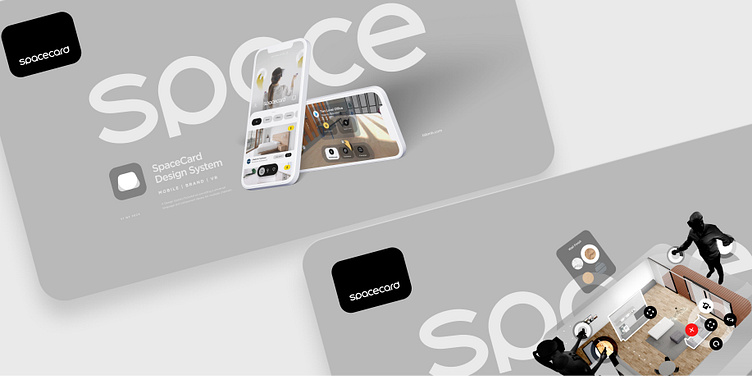Holistic Design System "Space"
Design, as the initial point of contact between a startup and the marketplace, shapes key aspects of a startup’s journey, from product desirability to perceived value and user experience. However, due to limited resources and high-pressure environments, design systems often take a back seat in startups, resulting in an outward perception of disorganization and incoherence.
Competitive startups can navigate these challenges by implementing lightweight yet holistic design systems across the company to separate themselves from competitors. A cohesive and unified image across all visual touchpoints portrays a competent and well-organized team that instills confidence in new customers and investors alike.
Take, for example, the holistic design system we built at SpaceCard.io. This system became the guiding framework for various domains, including branding, product, marketing, onboarding, and even package design. The intent is to demonstrate the compelling impact that a well-executed holistic system can have on the trajectory of a startup, signaling consistency and confidence to the market while empowering team autonomy to remain flexible within a defined framework.
Rapid iteration and refinement of visual components pave the way for startups to test solutions swiftly, confirm assumptions, and pivot as necessary. This process accelerates the journey to identify solutions that resonate with users across all touchpoints, encompassing product, marketing, sales, and even onboarding. A well-crafted design system not only supports the lean startup methodology but also propels it. Below are the top five considerations for startups as they set up their design vision and embed design systems thinking.
1. The Brand Comes First
Your brand is the bedrock of your startup. It embodies your mission, values, and persona, and sets the stage for all subsequent actions. Your brand should fuel your design vision, fostering a harmonized aesthetic that authentically reflects your unique ethos and strikes a chord with your target audience. All visual touchpoints should spring from this well-defined brand identity.
2. Start with High Frequency Components
While it’s important to envision your design across all touchpoints with a broad perspective, startups should adopt an iterative approach that prioritizes essential components. Start by focusing on elements that are frequently used throughout the product and make them the foundation of your product design system. Starting small allows your design to organically evolve alongside your startup, facilitating continuous improvement. Your engineers will thank you.text here...
3. Utilize an Outside-In Approach Beyond the Product
When it comes to design systems outside the product, startups should adopt an outside-in approach in their design system from the atomic design perspective. This approach mitigates design debt as your startup scales, allowing for larger structures like templates and patterns to be established first, before delving into finer atomic or molecular details. This strategy promotes coherence from the onset, simplifying the integration of complexity over time and ensuring that all design aspects align with your overarching vision. It also provides the necessary freedom to all other facets of the company to be flexible enough to adapt to the market. Your marketing and sales teams will thank you.
Enter your text here...
4. Balance Between Cohesion and Over-complication
As startups, we face a delicate balance between establishing guidelines and maintaining flexibility in our design systems. Too many rigid rules or an excessive focus on minutiae that larger tech corporations often deploy can be misleading and potentially burdensome for teams that need to stay nimble. Craft a design system that not only caters to your specific requirements but also allows for flexibility as your startup grows. Be mindful to avoid an overabundance of rigid design standards, which could restrict your adaptability and inadvertently contribute to your design debt.
5. Setting Healthy Habits with Engineering
Design systems can act as a conduit between design and engineering teams, promoting improved collaboration. Encourage habits that boost coherence between these teams and increase communication, set universal standards and form the foundation of the company’s operational model for product development. Again, the key is to tackle one component at a time, starting with the most used elements.
In conclusion, embracing design systems thinking from the start significantly enhances a startup’s agility and capacity to offer a cohesive and engaging experience. These considerations can guide your design vision and foster a robust design system, ultimately boosting growth and agility. The first impression counts. A well-coordinated design can make the difference between landing or losing that first customer or investor.



















